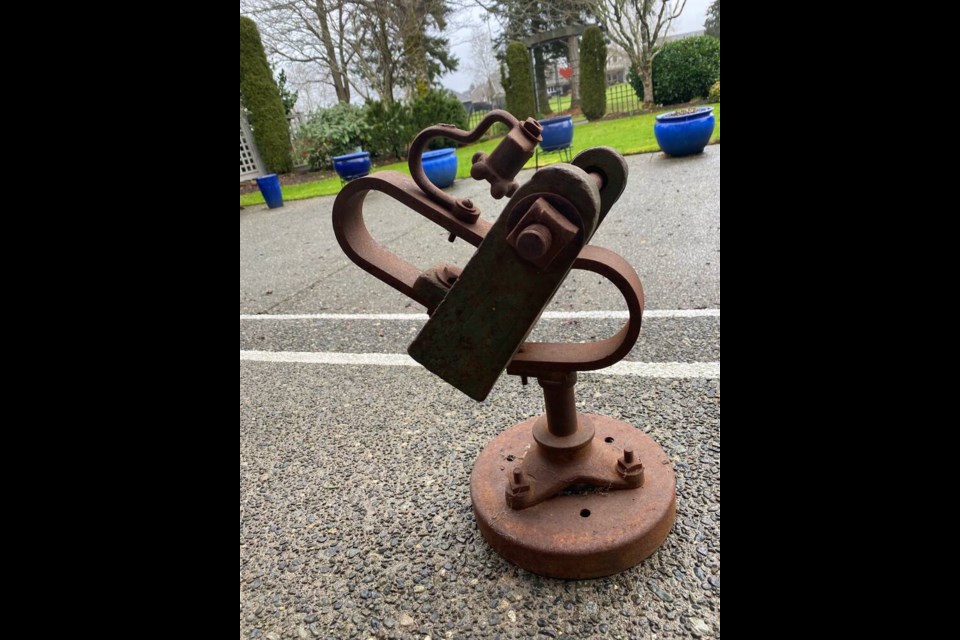Don’t think of the gizmo on Bob Brown’s Courtenay patio as a rainmaking machine.
Think of it as monument to the peculiarity of his weird Uncle Donald, which is what his family called the man back in Regina.
“He was eccentric with a capital E,” Brown says.
Not that he means that in a negative way. No sir. In a drearily conformist world, iconoclasts like Donald S. Johnston are a splash of bright paint against a dull canvas.
If that name sounds familiar, it’s because his story has been told before. Johnston gained a measure of celebrity in the 1940s and ‘50s after inventing what he claimed was a rainmaking device he called the “universcope.” Give him 36 hours — usually less — and he could make the sky fall, he told the Vancouver Sun in 1949, pointing to a string of successes.
His machine was said to produce an electro-magnetic gravitational pull on the moon to draw moisture from the Pacific and the Gulf of Mexico to the Prairies. One story said Johnston could even make his contraption work in reverse, as proven when swollen clouds didn’t burst over a Royal Canadian Mounted Police band concert.
If that all sounds a tad Wizard of Oz-ish, it didn’t deter Victoria’s Daily Colonist from co-sponsoring Johnston’s July 1951 expedition to the drought-stricken Saanich Peninsula, where desperate fruit farmers faced losing their crops.
Close to 100 people showed up as Johnston, portrayed by the Colonist as an underrated genius (“a prophet without honour in his own city”), set his metronomic moisture-maker swinging at moonrise in a farmer’s field east of Central Saanich Road between Tanner and Keating Cross.
Alas, skepticism sank in as the “50-pound moonpowered mystery machine,” as the rival Victoria Times sneeringly described it, failed to produce precipitation.
After four days, skepticism gave way to open scorn. Johnston snapped at the children who dogged his heels. The Times ran a satirical front-page story in which it announced it had arranged to send one Sol. C. Doocer, known as the Saanich Sun-Maker, to bring relief to flooded Wambeazle, Sask.
“Mr. Doocer has been so successful with recent heat-inducing experiments that many Saanich farmers hold him responsible for the unprecedented drought which has stricken the peninsula,” stated the story, which was accompanied by a photo of Doocer and his device, which involved the use of oscillating grapefruit.
When Johnston retreated to Regina, even the Colonist had to acknowledge reality with the headline Sunburned Rainmaker Admits Defeat.
That was the last we heard of the universcope.
Until now.
Now it has returned to Vancouver Island, at Brown’s home in Courtenay. It doesn’t look like much: a knee-high, oddly shaped apparatus that seems more suited to anchoring a boat than affecting the pull of the moon.
Brown, who retired as the Regina school board’s director of education, brought the device west a couple of years ago after rescuing it from his grandparents’ attic in the Saskatchewan capital. It sits on his patio.
“I have great fun having guests guess what it is,” he says. “Not surprisingly, no one has come close.”
Brown says the universcope’s curved bits were the magnets that would set it rocking back and forth. “It was almost like a perpetual motion machine.”
And yes, Johnston had faith in his invention. “Who knows where he came up with that, but he believed in it.”
Brown, whose mother was Johnston’s big sister, remembers his uncle as a cantankerous man who “walked that thin line between genius and insanity.”
“He lived with his parents for his whole life, never had a job and lived on a weekly allowance that enabled him to visit various coffeeshops and smoke two pack of cigarettes every day.”
Johnston had talents, though. “He dabbled in painting and did some writing.” Johnston’s portrait of George Bernard Shaw, painted on a large piece of plywood, now hangs in the chambers of Brown’s nephew, a judge. Ripley’s Believe It Or Not once published a poem Johnston wrote that read the same way both forwards and backwards. “He won a complete set of encyclopedias for that,” Brown says.
Johnston died in 1974.
Perhaps it is appropriate that his universcope came to rest on Vancouver Island, this being the contrarian capital of Canada, the home of so many people who not only march to a different drummer, but dance to a horn section that no one else can hear.
Here, at the edge of the country, as far from the mainstream as you can get, eccentrics are celebrated, cherished and occasionally elected, a legacy that goes all the way back to the founder of this newspaper and B.C.’s second premier, Amor de Cosmos, whose fear of electricity left him unwilling to ride streetcars and who was known to start fist fights in the street.
As Brown’s father liked to say, it takes all kinds to make the world go around.



